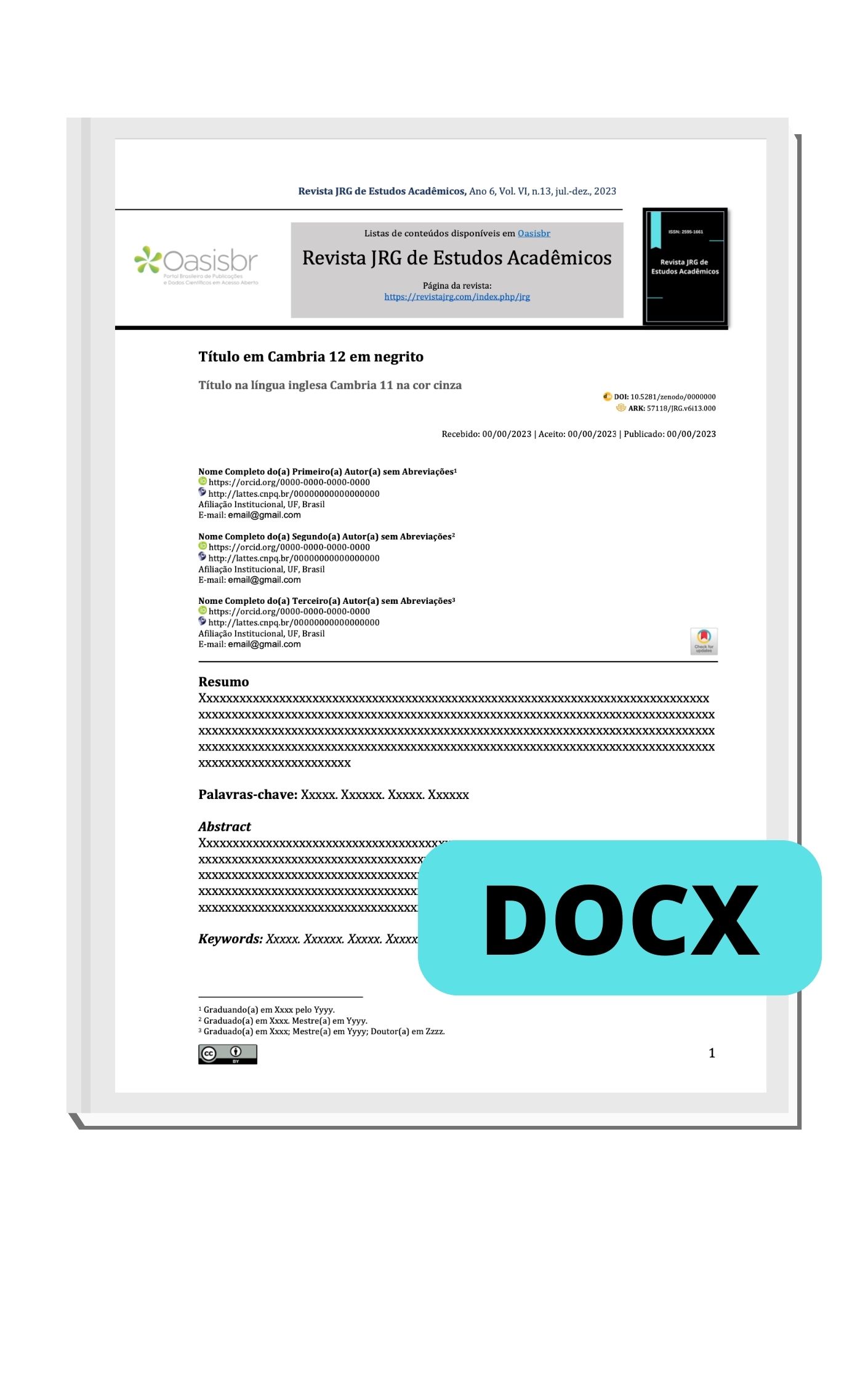Avaliação do nível sérico de sódio em pacientes hospitalizados na enfermaria da clínica médica do Hospital Universitário da Universidade Federal de Sergipe
DOI:
https://doi.org/10.55892/jrg.v8i18.1905Palabras clave:
Hiponatremia, Mortalidade Hospitalar, Tempo de InternaçãoResumen
Objetivo: Avaliar a frequência, o impacto sobre o tempo de internação, evolução clínica, fatores associados e óbitos desta condição clínica em nosso meio. Métodos: Estudo transversal observacional descritivo, realizado em amostra de 80 indivíduos, composta por 39 (48,7%) pacientes do sexo feminino e 41 (51,3%) do sexo masculino. Dados demográficos, clínicos, laboratoriais, comorbidades, medicações em uso e tempo de internação foram coletados. Resultados: Durante o período de estudo, 44 (55%) pacientes apresentaram hiponatremia. O tempo de hospitalização dos pacientes admitidos com hiponatremia, (29,5 ± 29,7 dias), foi maior quando comparado ao tempo de hospitalização dos pacientes admitidos com eunatremia, que tiveram tempo de hospitalização médio de 20,8 dias. Nenhum paciente do estudo foi a óbito. Foi proposto algum tipo de tratamento para 22 (50%) dos pacientes hiponatrêmicos. Na alta hospitalar, 30 (37,5%) pacientes encontravam-se em hiponatremia. 20 (80%) dos 25 pacientes em uso de diuréticos tiveram hiponatremia. 12 (70,5%) dos 17 pacientes que fizeram uso de antidepressivos tiveram hiponatremia. Cinco (71,4%) dos sete pacientes com diagnóstico de Insuficiência Cardíaca Congestiva eram pacientes hiponatrêmicos. Quatro (80%) dos cinco pacientes com diagnóstico de cirrose hepática eram hiponatrêmicos. Quatro (80%) dos cinco pacientes com diagnóstico de Doença Renal Crônica eram hiponatrêmicos. Conclusão: A hiponatremia é um distúrbio eletrolítico comum em pacientes hospitalizados no HU-UFS, implica no maior tempo de hospitalização e readmissão hospitalar. Infere-se que o uso de diuréticos, antidepressivos e patologias prévias apresentadas pelos pacientes como Insuficiência Cardíaca Congestiva, Doença Renal Crônica e Cirrose contribuem para o surgimento da hiponatremia.
Descargas
Citas
ADROGUÉ, H. J.; MADIAS, N. E. Diagnosis and Treatment of Hyponatremia. American Journal of Kidney Diseases, [s. l.], v. 64, n. 5, p. 681–684, 2014. Disponível em: https://linkinghub.elsevier.com/retrieve/pii/S0272638614008932. Acesso em: 7 fev. 2025.
ALLAN, P.; GANGULY, S. HIPONATREMIA. [S. l.]: William English, [s. d.]. Disponível em: https://www.sbahq.org/wp-content/uploads/2016/06/9cbb843e883709f94f3b62a9d7dd37e3-314-HIPONATREMIA.pdf. Acesso em: 7 fev. 2025.
ASADOLLAHI, K.; BEECHING, N.; GILL, G. Hyponatraemia as a risk factor for hospital mortality. QJM: An International Journal of Medicine, [s. l.], v. 99, n. 12, p. 877–880, 2006. Disponível em: https://doi.org/10.1093/qjmed/hcl120. Acesso em: 7 fev. 2025.
BREUER, R.; RUBINOW, A. Inappropriate Secretion of Antidiuretic Hormone and Mycoplasma Pneumonia Infection. Respiration, [s. l.], v. 42, n. 3, p. 217–219, 2009. Disponível em: https://doi.org/10.1159/000194431. Acesso em: 7 fev. 2025.
CALLAHAN, M. A. et al. Economic Impact of Hyponatremia in Hospitalized Patients: A Retrospective Cohort Study. Postgraduate Medicine, [s. l.], v. 121, n. 2, p. 186–191, 2009. Disponível em: https://doi.org/10.3810/pgm.2009.03.1991. Acesso em: 7 fev. 2025.
CAWLEY, M. J. Management of Hyponatremia in Hospitalized Patients: Role of Pharmacists in Improving Patient Care. [S. l.: s. n.], 2012. Disponível em: https://www.researchgate.net/publication/357285777_Management_of_Hyponatremia_in_Hospitalized_Patients_Role_of_Pharmacists_in_Improving_Patient_Care. Acesso em: 7 fev. 2025.
CUMMING, K. et al. Prevalence, Incidence and Etiology of Hyponatremia in Elderly Patients with Fragility Fractures. PLOS ONE, [s. l.], v. 9, n. 2, p. e88272, 2014. Disponível em: https://journals.plos.org/plosone/article?id=10.1371/journal.pone.0088272. Acesso em: 7 fev. 2025.
FILIPPATOS, T. D. et al. Hyponatremia in the elderly: challenges and solutions. Clinical Interventions in Aging, [s. l.], v. 12, p. 1957–1965, 2017. Disponível em: https://www.tandfonline.com/doi/abs/10.2147/CIA.S138535. Acesso em: 7 fev. 2025.
FILIPPATOS, T.; ELISAF, M.; LIAMIS, G. Pharmacological management of hyponatremia. Expert Opinion on Pharmacotherapy, [s. l.], v. 19, n. 12, p. 1337–1344, 2018. Disponível em: https://www.tandfonline.com/doi/full/10.1080/14656566.2018.1504920. Acesso em: 7 fev. 2025.
GANKAM KENGNE, F.; DECAUX, G. Hyponatremia and the Brain. Kidney International Reports, [s. l.], v. 3, n. 1, p. 24–35, 2018. Disponível em: https://linkinghub.elsevier.com/retrieve/pii/S246802491730373X. Acesso em: 7 fev. 2025.
GÓMEZ-HOYOS, E. et al. Prevalence of Hyponatremia and Its Associated Morbimortality in Hospitalized Patients Receiving Parenteral Nutrition. Annals of Nutrition and Metabolism, [s. l.], v. 71, n. 1–2, p. 1–7, 2017. Disponível em: https://doi.org/10.1159/000477675. Acesso em: 7 fev. 2025.
HAWKINS, R. C. Age and gender as risk factors for hyponatremia and hypernatremia. Clinica Chimica Acta, [s. l.], v. 337, n. 1, p. 169–172, 2003. Disponível em: https://www.sciencedirect.com/science/article/pii/S0009898103003784. Acesso em: 7 fev. 2025.
HOORN, E. J.; LINDEMANS, J.; ZIETSE, R. Development of severe hyponatraemia in hospitalized patients: treatment-related risk factors and inadequate management. Nephrology Dialysis Transplantation, [s. l.], v. 21, n. 1, p. 70–76, 2006. Disponível em: https://doi.org/10.1093/ndt/gfi082. Acesso em: 7 fev. 2025.
KOVESDY, C. P. et al. Hyponatremia, Hypernatremia, and Mortality in Patients With Chronic Kidney Disease With and Without Congestive Heart Failure. Circulation, [s. l.], v. 125, n. 5, p. 677–684, 2012. Disponível em: https://www.ahajournals.org/doi/full/10.1161/CIRCULATIONAHA.111.065391. Acesso em: 7 fev. 2025.
KRISHNA, C. et al. A STUDY ON HYPONATREMIA IN HOSPITALIZED PATIENTS. International Journal of Advanced Research, [s. l.], v. 6, n. 4, p. 1063–1066, 2018. Disponível em: http://www.journalijar.com/article/23381/a-study-on-hyponatremia-in-hospitalized-patients/. Acesso em: 7 fev. 2025.
KURAMATSU, J. B. et al. Hyponatremia Is an Independent Predictor of In-Hospital Mortality in Spontaneous Intracerebral Hemorrhage. Stroke, [s. l.], v. 45, n. 5, p. 1285–1291, 2014. Disponível em: https://www.ahajournals.org/doi/full/10.1161/STROKEAHA.113.004136. Acesso em: 7 fev. 2025.
LIEN, Y.-H. H. Antidepressants and Hyponatremia. The American Journal of Medicine, [s. l.], v. 131, n. 1, p. 7–8, 2018. Disponível em: https://www.amjmed.com/article/S0002-9343(17)30920-8/fulltext. Acesso em: 7 fev. 2025.
LOMTE, S. S. et al. CLINICAL PROFILE OF HYPONATRAEMIA IN A TERTIARY CARE HOSPITAL. Journal of Evidence Based Medicine and Healthcare, [s. l.], v. 4, n. 60, p. 3607–3613, 2017. Disponível em: https://www.jebmh.com/data_pdf/Srirang%20-%202%20-%20FINAL%20-%20(Issue%2060).pdf. Acesso em: 7 fev. 2025.
MILLER, A. et al. Approach to Hyponatremia in Congestive Heart Failure: A Survey of Canadian Specialist Physicians and Trainees. Canadian Journal of Kidney Health and Disease, [s. l.], v. 3, p. 94, 2016. Disponível em: https://doi.org/10.1186/s40697-016-0094-9. Acesso em: 7 fev. 2025.
NANKABIRWA, H. et al. A cross-sectional study of hyponatraemia among elderly patients with heart failure in Uganda. BMJ Open, [s. l.], v. 6, n. 5, p. e009775, 2016. Disponível em: https://bmjopen.bmj.com/content/6/5/e009775. Acesso em: 7 fev. 2025.
PATIL, S.; MUKHERJI, A.; SHETTY, A. Incidence of Hyponatremia in Critically Ill Patients in Intensive Care Unit: Observational Study. International Journal of Dental and Medical Specialty, [s. l.], v. 3, n. 1and2, p. 12, 2016. Disponível em: https://renupublishers.com/images/article/146849121904_IJDMS_3(1)_02_OA.pdf. Acesso em: 7 fev. 2025.
RAFAT, C. et al. Hyponatremia in the intensive care unit: How to avoid a Zugzwang situation?. Annals of Intensive Care, [s. l.], v. 5, n. 1, p. 39, 2015. Disponível em: https://doi.org/10.1186/s13613-015-0066-8. Acesso em: 7 fev. 2025.
ROCHA, P. N. Hiponatremia: conceitos básicos e abordagem prática. Brazilian Journal of Nephrology, [s. l.], v. 33, p. 248–260, 2011. Disponível em: https://www.scielo.br/j/jbn/a/ggcdv7X6mjHSyVRtcY8fTxS/?format=html. Acesso em: 7 fev. 2025.
SAHA, B. K. et al. In-Hospital Outcomes in Acute ST- Elevation Myocardial on Effects of Early Development of Hyponatremia: A study in National Institute of Cardiovascular Diseases and Hospital, Dhaka, Bangladesh. Journal of Dental and Medical Sciences, [s. l.], v. 18, n. 12, p. 01–06, 2019.
SCHRIER, R. W.; SHARMA, S.; SHCHEKOCHIKHIN, D. Hyponatraemia: more than just a marker of disease severity?. Nature Reviews Nephrology, [s. l.], v. 9, n. 1, p. 37–50, 2013. Disponível em: https://www.nature.com/articles/nrneph.2012.246. Acesso em: 7 fev. 2025.
SOIZA, R. L. et al. Hyponatremia predicts mortality after stroke. International Journal of Stroke, [s. l.], v. 10, n. SA100, p. 50–55, 2015. Disponível em: https://doi.org/10.1111/ijs.12564. Acesso em: 7 fev. 2025.
SOIZA, R. L. et al. Hyponatremia: Special Considerations in Older Patients. Journal of Clinical Medicine, [s. l.], v. 3, n. 3, p. 944–958, 2014. Disponível em: https://www.mdpi.com/2077-0383/3/3/944. Acesso em: 7 fev. 2025.
STERNS, R. H.; HIX, J. K.; SILVER, S. M. Management of Hyponatremia in the ICU. Chest, [s. l.], v. 144, n. 2, p. 672–679, 2013. Disponível em: https://www.sciencedirect.com/science/article/pii/S0012369213605486. Acesso em: 7 fev. 2025.
VAA, B. E. et al. Influence of Serum Sodium on MELD-Based Survival Prediction in Alcoholic Hepatitis. Mayo Clinic Proceedings, [s. l.], v. 86, n. 1, p. 37–42, 2011. Disponível em: https://www.sciencedirect.com/science/article/pii/S0025619611601171. Acesso em: 7 fev. 2025.
VERBALIS, J. G. et al. Diagnosis, Evaluation, and Treatment of Hyponatremia: Expert Panel Recommendations. The American Journal of Medicine, [s. l.], v. 126, n. 10, Supplement 1, Diagnosis, Evaluation, and Treatment of Hyponatremia: Expert Panel Recommendations, p. S1–S42, 2013. Disponível em: https://www.sciencedirect.com/science/article/pii/S0002934313006050. Acesso em: 7 fev. 2025.
WAIKAR, S. S.; MOUNT, D. B.; CURHAN, G. C. Mortality after Hospitalization with Mild, Moderate, and Severe Hyponatremia. The American Journal of Medicine, [s. l.], v. 122, n. 9, p. 857–865, 2009. Disponível em: https://linkinghub.elsevier.com/retrieve/pii/S0002934309002800. Acesso em: 7 fev. 2025.
WALD, R. et al. Impact of Hospital-Associated Hyponatremia on Selected Outcomes. Archives of Internal Medicine, [s. l.], v. 170, n. 3, p. 294–302, 2010. Disponível em: https://doi.org/10.1001/archinternmed.2009.513. Acesso em: 7 fev. 2025.











































